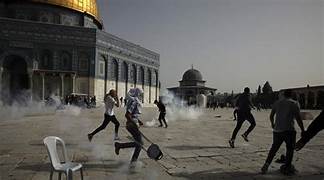Introduction
The Gaza Strip, a small territory situated along the eastern Mediterranean coastline, has been the center of a longstanding and multifaceted conflict. The situation in Gaza is marked by political, economic, and humanitarian challenges that have persisted for decades. This article aims to shed light on the complex and often dire circumstances in Gaza, exploring the historical context, ongoing issues, and the importance of international efforts for peace.
Historical Background
The roots of the Gaza conflict can be traced back to the mid-20th century. In 1947, the United Nations passed a plan for the partition of Palestine, leading to the establishment of Israel in 1948. This resulted in a series of Arab-Israeli wars, with Gaza coming under Egyptian administration, while the West Bank was controlled by Jordan.
The situation in Gaza took a significant turn during the Six-Day War in 1967 when Israel captured the territory. It remained under Israeli military occupation until 2005 when Israel unilaterally withdrew its settlers and troops. Since then, Gaza has been governed by Hamas, a Palestinian political and military organization, while Israel maintains control over its borders, airspace, and coastal waters.
Current Challenges
- Humanitarian Crisis: Gaza is faced with a dire humanitarian crisis. High population density, limited access to clean water, inadequate healthcare, and electricity shortages have created immense suffering for its residents. The ongoing blockade has significantly constrained the flow of goods and people in and out of the territory.
- Political Division: The political division between the West Bank-based Palestinian Authority and Gaza-based Hamas continues to impede efforts for Palestinian unity. The division affects governance, social services, and infrastructure development in Gaza.
- Security and Conflict: Gaza has witnessed multiple conflicts, with sporadic exchanges of hostilities between Hamas and Israel. These conflicts have resulted in casualties, destruction, and a pervasive sense of insecurity for residents.
- Economic Challenges: The lack of economic opportunities and employment options has led to high poverty rates in Gaza. The blockade has severely restricted the movement of goods and people, limiting trade and hindering economic development.
- Access to Education: Educational opportunities in Gaza are constrained due to overcrowded schools, lack of resources, and the emotional toll of ongoing conflict. The prospects for Gaza’s youth remain limited.
International Efforts and Solutions
Resolving the situation in Gaza requires international involvement and a comprehensive approach:
- Lifting the Blockade: The international community should work towards the gradual lifting of the blockade to allow for the free flow of goods and people, while addressing legitimate security concerns.
- Reconciliation and Unity: Efforts should be made to facilitate reconciliation and unity between Palestinian political factions, bridging the divide between the West Bank and Gaza.
- Humanitarian Assistance: Increased humanitarian aid should be provided to alleviate the suffering of Gaza’s population. Access to clean water, healthcare, and education should be prioritized.
- Peace Negotiations: A just and lasting resolution to the Israeli-Palestinian conflict is essential. Resuming peace negotiations with the involvement of key international actors can lead to a comprehensive two-state solution.
- Ceasefire and Diplomacy: Efforts to maintain and consolidate ceasefires, as well as diplomatic dialogues, are crucial to prevent further escalation and build trust between the parties involved.
Conclusion
The situation in Gaza remains a challenging and multifaceted issue that has profound implications for its residents and the broader Middle East. Addressing the ongoing conflict and humanitarian crisis requires the concerted efforts of the international community, including regional and global stakeholders. Resolving the situation in Gaza is not only a matter of political importance but also a humanitarian imperative, essential for the well-being and security of all those affected by the conflict in the region.












